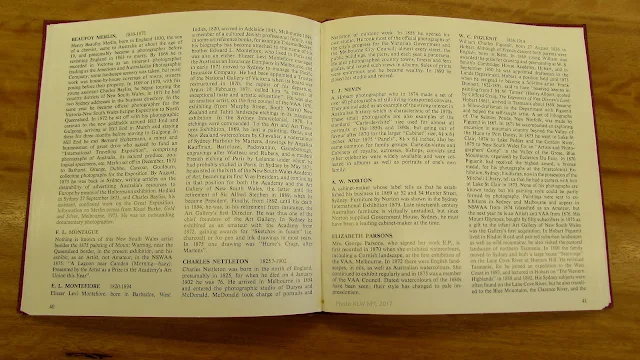DEATHS of MARY ANN CARR and DAUGHTER
DESECRATION of GRAVE
MARTHA NEVIN, formerly SALTER, nee GENGE
 Thomas Nevin's stereo of his sister Mary Anne Nevin ca. 1870 dipping a glass at the creek, Kangaroo Valley Hobart
Photo copyright © KLW NFC 2012. Private Collection.
T
Thomas Nevin's stereo of his sister Mary Anne Nevin ca. 1870 dipping a glass at the creek, Kangaroo Valley Hobart
Photo copyright © KLW NFC 2012. Private Collection.
There was tragedy awaiting Thomas Nevin's younger sister Mary Ann, though they would hardly have anticipated what it might be when he took this photograph - almost as a snapshot - of her ca. 1868-1870 at the New Town Creek, Kangaroo Valley (Tasmania). The family had already lost one sister,
Rebecca Jane Nevin to illness by 1865, the year that Mary Ann applied unsuccessfully to the Board of Education to establish a school at Kangaroo Valley with the support of family friend Morton Allport. But she persisted on her own account with support from her father, John Nevin snr, and used the schoolhouse adjoining the Wesleyan Chapel close by the house her father had built on land owned by the Wesleyan Trust, up the hill from the Lady Franklin Museum at Ancanthe.
In 1875, her father John Nevin snr was granted a license to teach adult males at night at the Wesleyan schoolhouse, Kangaroo Valley. His wife Mary Ann nee Dickson, (sister of the Newtonards nurseryman Alexander Dickson) and mother to Mary Ann and her two brothers, photographer Thomas Nevin and Constable John Nevin, had died in the same year. By May 1877 their surviving sister Mary Ann Nevin had married mariner Captain John Carr at the Wesleyan Chapel, Kangaroo Valley, and moved to Victoria. In 1878, she died of peritonitis 22 days after delivering her daughter Mary Ann Carr at Railway Place, Sandridge. Her husband, mariner John Carr, remained in Victoria and surrendered the child to his father-in-law. Her daughter was returned to the care of Thomas and Jack Nevin's father John Nevin snr in 1879 at Kangaroo Valley, New Town, Tasmania. John Nevin snr made the heartfelt decision in 1879 to remarry in order to provide his grandchild Mary Ann Carr with a maternal presence. He married Martha Genge, the widowed daughter of his close friend, Wesleyan preacher William Genge. At the time of their marriage and their adoption of his daughter's daughter, John Nevin snr was 71 yrs old, and Martha Genge, (widowed as Salter) was 46 years old. The grandchild was named Mary Ann after her mother (Mary Ann Carr nee Nevin, 1845-1878), her grandmother (Mary Ann Nevin nee Dickson, 1810-1875) and later nicknamed Minnie after her cousin Mary Anne Drew nee Nevin (1884-1974), who was born to Thomas and Elizabeth Nevin in 1884.
 Archives Office of Tasmania
Marriage of John Carr to Mary Anne Nevin, 3 May 1877
NAME_INDEXES:884210
Resource RGD37/1/36 no 359
Archives Office of Tasmania
Marriage of John Carr to Mary Anne Nevin, 3 May 1877
NAME_INDEXES:884210
Resource RGD37/1/36 no 359
[Above:] Marriage of Mary Anne Nevin, 31 years old, gardener's daughter, to John Carr, 37 yrs old, seaman, on 3rd May 1877 at the Wesleyan Church, Kangaroo Valley, New Town Hobart.
Witnesses were her father John Nevin snr, her brother John Nevin jnr, her sister-in-law Mary Sophia Day (sister of Thomas Nevin's wife Elizabeth Rachel Nevin nee Day) and Mary Hurst (1839-1925), sister of Thomas Nevin's friend, surveyor John Hurst.
Thomas Nevin's niece, known thereafter as Minnie Carr who survived her mother's death three weeks after birth was raised by her grandfather John Nevin snr and his second wife Martha Nevin, formerly Salter, nee Genge, When John Nevin snr died in 1887 (b. 1808), Martha Nevin moved from Kangaroo Valley (New Town) to 76 Patrick Street, Hobart and continued to care for her step-granddaughter Minnie Carr, but within a decade Minnie Carr would also "
join the great majority", to use her grandfather's poetic turn of phrase. In 1898 and just 20 yrs old, she died suddenly of gastric poisoning and haemorrhage. The funeral notice simply stated that at the time of her death she was living at her mother's house, though that was not strictly correct. Martha Nevin was her step-grandmother by way of her grandfather John Nevin snr's 'second marriage, not her mother or even step mother, but because of Martha Nevin's relative youth in 1879 when she married John Nevin, she was most likely considered a step-mother rather than step-grandmother to the child whom she had raised, practically from birth.
 [Above] Thomas Nevin's stereograph of his sister Mary Ann Nevin ca. 1870
Photographed with four children, one holding a toddler, and a tall man in shirt sleeves at the Kangaroo Valley school (in background) where both she and her father John Nevin snr were teachers.
Tasmanian Museum and Art Gallery Collection
TMAG Ref: Q16826.1.2 [scan 2015]. Verso below.
[Above] Thomas Nevin's stereograph of his sister Mary Ann Nevin ca. 1870
Photographed with four children, one holding a toddler, and a tall man in shirt sleeves at the Kangaroo Valley school (in background) where both she and her father John Nevin snr were teachers.
Tasmanian Museum and Art Gallery Collection
TMAG Ref: Q16826.1.2 [scan 2015]. Verso below.
 Verso: Thomas Nevin's stereograph of his sister Mary Ann Nevin ca. 1870
Photographed with four chidren, one holding a toddler, and a tall man in shirt sleeves at the Kangaroo Valley school (in background) where both she and her father John Nevin snr were teachers.
Tasmanian Museum and Art Gallery Collection
TMAG Ref: Q16826.1.2 [scan 2015].
Verso: Thomas Nevin's stereograph of his sister Mary Ann Nevin ca. 1870
Photographed with four chidren, one holding a toddler, and a tall man in shirt sleeves at the Kangaroo Valley school (in background) where both she and her father John Nevin snr were teachers.
Tasmanian Museum and Art Gallery Collection
TMAG Ref: Q16826.1.2 [scan 2015].
 Death of Thomas J. Nevin's sister Mary Ann Carr (1845-1878)
Public Records Office of Victoria No. 9830
Death of Thomas J. Nevin's sister Mary Ann Carr (1845-1878)
Public Records Office of Victoria No. 9830
Details: Death certificate of Mary Ann Carr nee Nevin, of Railway Place, Borough of Sandridge (Victoria), dated 27th July 1878. Buried at Melbourne General Cemetery. Registered as a married woman, 33 years old, born in County Down, Ireland, formerly of Kangaroo Valley, New Town, Tasmania, lived 6½ months in Victoria. Wife of mariner John Carr. Death due to peritonitis 22 days after the birth of her daughter, Mary Ann. Parents registered as John Nevin, listed here as a labourer, and mother Mary Ann Nevin formerly Dickson.
 Mercury, 9th August 1878
Mercury, 9th August 1878
CARR. - On July 27, at her residence, Sandridge, Victoria, in the 34th year of her age, Mary Ann, the beloved wife of John Carr, the only surviving daughter of Mr. John Nevin, Kangaroo Valley, New Town.
The Grandfather's Second Marriage
Four years after the death from bladder complications of Thomas J. Nevin's mother Mary Ann Nevin nee Dickson (1810-1875), his father John Nevin snr (1808-1887) re-married, and to a much younger woman, widow Martha Salter nee Genge (1833-1925), daughter of his close friend, Methodist lay preacher and church sexton William Genge. At the time of their marriage in October
1879, John Nevin was 71 yrs old, and Martha Salter was 46 yrs old. The age difference might even stir comment in this day and age, but there was an urgent reason behind this marriage which centered on John Nevin's grand-daughter, Minnie Carr.
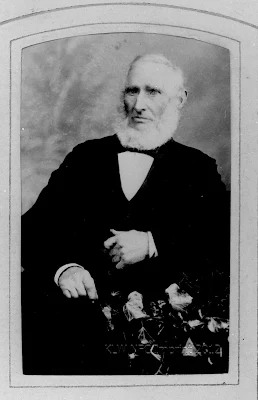
 John Nevin snr, (1808-1887)
Tasmanian Archives and Heritage Office
TAHO Ref: NS434/1/155 copy
Original photo by his son Thomas J. Nevin taken at his New Town studio October 1879
Photo copyright © KLW NFC 2012
Martha Nevin, formerly Salter, nee Genge (1833-1925)
Tasmanian Archives and Heritage Office
TAHO Ref: NS434/1/194 copy
Original photos by Thomas J. Nevin taken at his New Town studio October 1879
Photo copyright © KLW NFC 2012
John Nevin snr, (1808-1887)
Tasmanian Archives and Heritage Office
TAHO Ref: NS434/1/155 copy
Original photo by his son Thomas J. Nevin taken at his New Town studio October 1879
Photo copyright © KLW NFC 2012
Martha Nevin, formerly Salter, nee Genge (1833-1925)
Tasmanian Archives and Heritage Office
TAHO Ref: NS434/1/194 copy
Original photos by Thomas J. Nevin taken at his New Town studio October 1879
Photo copyright © KLW NFC 2012
 Archives Office Tasmania
Marriage of John Nevin snr and Martha Salter 23 October 1879
Kangaroo Valley New Town Tasmania
Record ID: NAME_INDEXES:888757
Resource RGD37/1/38 no 711
Archives Office Tasmania
Marriage of John Nevin snr and Martha Salter 23 October 1879
Kangaroo Valley New Town Tasmania
Record ID: NAME_INDEXES:888757
Resource RGD37/1/38 no 711
[Above]: The marriage registration of John Nevin snr and Martha Salter nee Genge, 23rd October 1879 at Kangaroo Valley New Town. His age was 71, and his status/rank was listed as gardener. Her age was 46, living with her father, Sexton of Church, Description given was John Nevin, widower, Martha Salter, widow. Her mark X was inserted between her first name and surname, possibly indicating that her maiden name was to be added. Witnesses were James Genge, Martha Salter nee Genge's father, and F. R Alomes, a 30yr old farmer. Henry Moore officiated as Clergyman.
Disambiguation: Mary Ann Carr
Four women across three generations in Thomas Nevin's family were given the name "Mary Ann" at birth:
1. Thomas J. Nevin's
mother, Mary Ann Nevin nee Dickson (born Edinburgh 1810, sister of Alexander Dickson, nurseryman of Newtonards, Ireland) who died in Hobart on 13th April 1875, aged 65 yrs, wife of John Nevin snr, and mother of Thomas James, Rebecca Jane, Mary Ann and William John Nevin. The family arrived as free settlers on board the
Fairlie in July 1852.
 [Above:] Thomas Nevin's photograph of his mother Mary Ann Nevin ca. 1873
Copyright © KLW NFC Imprint and Shelverton Family Collections 2007
2
[Above:] Thomas Nevin's photograph of his mother Mary Ann Nevin ca. 1873
Copyright © KLW NFC Imprint and Shelverton Family Collections 2007
2. Thomas J. Nevin's
sister, Mary Ann Carr nee Nevin (born Newtonards Ireland 1847) who married John Carr, son of Captain James Carr, at Kangaroo Valley, New Town, Hobart in May, 1877 and died at Sandridge Victoria in 1878 giving birth to her daughter, also named Mary Ann Carr..
 [Above] Thomas Nevin's mounted carte-de-visite portrait of his sister Mary Anne Nevin ca. 1874
Married John Carr 1877. Photo copyright © KLW NFC 2005. Private Collection.
3
[Above] Thomas Nevin's mounted carte-de-visite portrait of his sister Mary Anne Nevin ca. 1874
Married John Carr 1877. Photo copyright © KLW NFC 2005. Private Collection.
3. Thomas J. Nevin's
daughter, Mary Ann Nevin (Hobart 1884-1974), known as Minnie to the family, and as Minnie Drew when she married. Grand daughter of John Nevin snr, and cousin of Minnie Carr.
 Minnie Nevin (1884-1974), aged 15yrs, ca. 1900
Daughter of Thomas and Elizabeth Nevin
Photo by Thomas Nevin, New Town Studio
Tasmanian Archives Collection (TAHO)
Black and white copy deposited 30/8/1974
Ref: NS434/1/230
4
Minnie Nevin (1884-1974), aged 15yrs, ca. 1900
Daughter of Thomas and Elizabeth Nevin
Photo by Thomas Nevin, New Town Studio
Tasmanian Archives Collection (TAHO)
Black and white copy deposited 30/8/1974
Ref: NS434/1/230
4. Thomas J, Nevin's
niece, Mary Ann Carr, known as Minnie Carr (born Sandridge Victoria 1878 - died Hobart 1898), daughter of his deceased sister Mary Ann Carr nee Nevin, She was brought back to Tasmania in 1879. Her grandfather John Nevin snr married Martha Salter nee Genge in October 1879, who then became her "mother", young enough at 46 yrs old to cope with a toddler, hence the
reason for the marriage between John Nevin snr and Martha Salter nee Genge, sister of Mary Chandler nee Genge.
The loss to Thomas Nevin and his younger brother Jack (William John) of their sister Mary Ann in childbirth in 1878 was a sudden shock,and yet one more loss to the family of immediate female relatives. Their only other sister Rebecca Jane Nevin had died in 1866 at Kangaroo Valley, aged 18 years, and their mother had died in 1875. In 1879, their father John Nevin made the
in loco parentis decision to adopt his motherless grand-daughter Mary Ann Carr by bringing her back to Tasmania from Victoria, and marrying Martha Salter nee Genge, as a means of providing the child with a maternal carer. She became the fourth female in the Nevin family over three generations to be known as Mary Ann, and the second with the moniker "Minnie".
Mary Ann poisoned
Living at Kangaroo Valley, New Town Tasmania, Mary Ann or Minnie Carr, John Nevin's granddaughter was brought up within the family circle of her cousins of about the same age, the children of her aunt and uncle, Elizabeth Rachel Nevin nee Day and photographer Thomas J. Nevin. But she was soon to lose her grandfather John Nevin. When he died in 1887 at Kangaroo Valley, she moved to 76 Patrick Street, Hobart, with her step-grandmother, Mrs Martha Nevin (formerly Salter, nee Genge) who was a widow again at 54 yrs old. Minnie Carr was not listed in the Post Office Directories at Martha Nevin's house in 1898, the year of her death or earlier because she was under 21 years old.

 Martha Nevin, mispelt as NIVEN, 76 Patrick St Hobart
Post Office Directories, p.100, 1897 and p.106, 1898
Martha Nevin, mispelt as NIVEN, 76 Patrick St Hobart
Post Office Directories, p.100, 1897 and p.106, 1898
At 76 Patrick Street, Hobart, widowed Mrs Martha Nevin took in a lodger, a young clerk called Arthur William Thomas Edwards, aged 22 yrs old. He was living there under the same roof in 1898 when Mary Ann or Minnie Carr, 20 years old, died suddenly of gastric poisoning and haemorrhage. The funeral notice said she died at the home of her
mother, which was incorrect because her mother had died giving birth to her in 1878, twenty years previously. Her step-grandmother, Mrs Martha Nevin, 63 years old by this time, was regarded as her mother. The Post Office directories of the years preceding and following 1898 mispelt her name as Mrs Martha "Niven". Other variations recorded in 19th century documents for Thomas Nevin's family include "Nevan" and "Navin".
So what really caused 20 year old Minnie Carr's death in 1898? Had she self-administered poison because she might have fallen pregnant to the 22 yr old Arthur W T Edwards? Did Minnie Carr want to end an affair going on under the nose of her "mother" Mrs Martha Nevin because the eligible Arthur W. T. Edwards had met Jane Wale and loudly proclaimed his intention to marry said Jane. who also resided in Patrick Street. Strange indeed that Arthur W. T. Edwards had moved out of Mrs Martha Nevin's house to another lodging in Melville Street between the time of Mary Ann's death and his marriage to Jane Wale just a few months later, on February 19th, 1899. Had Mary Ann been raped, to have suffered such haemorrhaging? Had he poisoned her? Was Arthur more than just a cad? Was he totally innocent of the misadventure, or was his fiancee the perpetrator and his accomplice?
 Marriage certificate of Arthur William Thomas Edwards to Louisa Jane Wale, 19th February 1899.
Marriages, Australia, Tasmania, Hobart. Archives Office Tasmania.
Marriage certificate of Arthur William Thomas Edwards to Louisa Jane Wale, 19th February 1899.
Marriages, Australia, Tasmania, Hobart. Archives Office Tasmania.
 Title: Photograph - Panoramic view of Hobart from Holy Trinity tower- shows Church Street and Patrick Street buildings and details of St Andrew's burial ground and city centre in background
Description: 1 photographic print
Format: Photograph
ADRI: NS2960-2-3
Source: Archives Office of Tasmania
Desecration of Mary Ann's grave
Title: Photograph - Panoramic view of Hobart from Holy Trinity tower- shows Church Street and Patrick Street buildings and details of St Andrew's burial ground and city centre in background
Description: 1 photographic print
Format: Photograph
ADRI: NS2960-2-3
Source: Archives Office of Tasmania
Desecration of Mary Ann's grave
By the time of his cousin Minnie Carr's death in September 1898, Tom Nevin, known as Sonny (i.e. Thomas J. Nevin jnr), the eldest son of photographer Thomas J. Nevin was the closest she had to an older brother. The death notice stated that her
mother's residence was at 76 Patrick Street, Hobart but in fact that was the address of her grandfather's widow, Martha Nevin who became her step-parents when Minnie's mother Mary Ann Carr died soon after giving birth in Victoria. Family members had left ribbons and cards at her graveside but within days, these tokens were stolen.
 Death notice for Mary Ann Carr
Mercury 30 September 1898
Death notice for Mary Ann Carr
Mercury 30 September 1898
TRANSCRIPT
DEATHS
CARR. - On September 28, 1898 at her mother's residence, 76, Patrick -street, Mary Ann Carr (Minnie), aged 20 years. Funeral will leave her late residence on SATURDAY, at 3 p.m., for Cornelian Bay Cemetery.
Sonny Nevin inserted an angry notice in the
Mercury, offering a reward to anyone who knew about the thief responsible for the desecration of his cousin's grave.
 Sergeant Thomas James Nevin jnr, aka “Sonny” ca. 1940s, in Salvation Army uniform.
Son of Thomas and Elizabeth Nevin, and cousin of Minnie Carr,
Taken shortly before his death in 1948.
Copyright © KLW NFC Pivate Collection 2009 ARR.
Sergeant Thomas James Nevin jnr, aka “Sonny” ca. 1940s, in Salvation Army uniform.
Son of Thomas and Elizabeth Nevin, and cousin of Minnie Carr,
Taken shortly before his death in 1948.
Copyright © KLW NFC Pivate Collection 2009 ARR.
 Sonny Nevin's notice in the Mercury 3 October 1898
Not to be confused with his father with same name
Desecration of his cousin Minne Carr's grave at Cornelian Bay cemetery.
TRANSCRIPT
Sonny Nevin's notice in the Mercury 3 October 1898
Not to be confused with his father with same name
Desecration of his cousin Minne Carr's grave at Cornelian Bay cemetery.
TRANSCRIPT
DESECRATION OF A GRAVE
Ribbons and Cards have been STOLEN from the grave of my cousin, Miss M. A, Carr, who was interred in the Cornelian Bay Cemetery on Saturday last, a reward will be paid for information as to the thief.
Apply
T. J. NEVIN, Elizabeth-street.
Source: Mercury 3 October 1898
Martha Salter nee Genge, relict of John Nevin snr
Martha Salter, widow, 42 years old, sailed from Plymouth (UK) on 21st June 1878 on board the
Somersetshire. She disembarked at Melbourne (Victoria) and boarded the
Tamar for Hobart Town, arriving on 16th August 1878 (Edward Freeman, agents). She was listed an an immigrant, 43 yrs old, without children, a Wesleyan who could read and whose stated qualification was "needlewoman". She was born in Taunton, Somersetshire, England, to William Genge, her father who was already resident in Hobart, the sponsor who paid the bounty of £16 for her ticket (No. 215). His application, as noted on this document, was signed off by B. Travers Solly on 16th August 1878, and forwarded to Treasury on 22nd August 1878.
 Salter, Martha
Record Type:Arrivals
Age:42
Arrival date:16 Aug 1878
Departure port:London
Ship:Somersetshire
Record ID:
NAME_INDEXES:1532439
Resource:
CB7/23/1/1 p124
Archives Office Tasmania
Salter, Martha
Record Type:Arrivals
Age:42
Arrival date:16 Aug 1878
Departure port:London
Ship:Somersetshire
Record ID:
NAME_INDEXES:1532439
Resource:
CB7/23/1/1 p124
Archives Office Tasmania
Little more than a year after arriving in Tasmania, Martha Salter nee Genge, daughter of William Genge stonemason at the Wesleyan Chapel, Melville St. Hobart, Tasmania, married John Nevin snr of Kangaroo Valley (now Lenah Valley), Tasmania.
 John Nevin snr, (1808-1887)
Tasmanian Archives and Heritage Office
TAHO Ref: NS434/1/155 copy
Original photo by his son Thomas J. Nevin taken at his New Town studio October 1879
Photos copyright © KLW NFC 2012
John Nevin snr, (1808-1887)
Tasmanian Archives and Heritage Office
TAHO Ref: NS434/1/155 copy
Original photo by his son Thomas J. Nevin taken at his New Town studio October 1879
Photos copyright © KLW NFC 2012
Martha Nevin, formerly Salter, nee Genge (1833-1925)
Tasmanian Archives and Heritage Office
TAHO Ref: NS434/1/194 copy
Original photos by Thomas J. Nevin taken at his New Town studio October 1879
Photos copyright © KLW NFC 2012
Martha Nevin formerly Salter nee Genge, was photographed at Thomas Nevin's studio, New Town in 1879, aged 46 years, on the occasion of her marriage to her second husband John Nevin, aged 71 yrs.
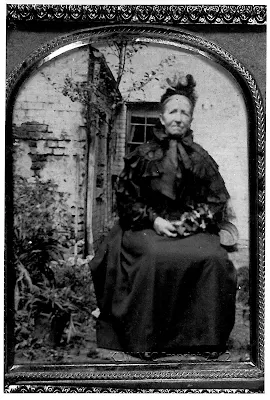 Martha Nevin nee Genge widow of John Nevin, taken ca. 1887-1890
TAHO Ref:NS434/1/19
Martha Nevin nee Genge widow of John Nevin, taken ca. 1887-1890
TAHO Ref:NS434/1/194
By the early 1920s, Martha Nevin, formerly Salter nee Genge (1833-1925) was in her late eighties when her nephew James Chandler photographed her with his mother, Mary Chandler nee Genge.
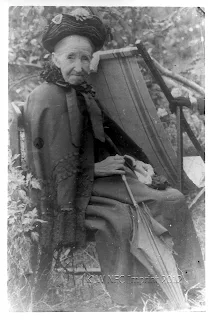 Martha Nevin nee Genge ca. 1920
TAHO Ref: NS434/1/248
Martha Nevin nee Genge ca. 1920
TAHO Ref: NS434/1/248
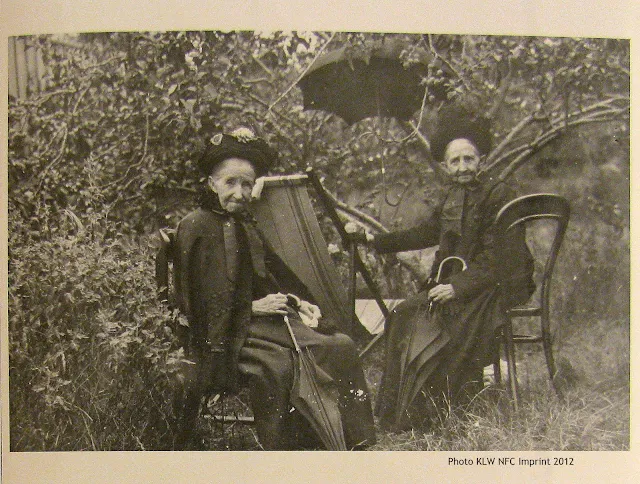 Photographer: James Chandler
TAHO Ref: NS434/1/103
Martha Nevin nee Genge (left) and her sister Mary Chandler nee Genge (right) at Mt Stuart, Hobart – ca. 1920.
Photos copyright KLW NFC 2012
Photographer: James Chandler
TAHO Ref: NS434/1/103
Martha Nevin nee Genge (left) and her sister Mary Chandler nee Genge (right) at Mt Stuart, Hobart – ca. 1920.
Photos copyright KLW NFC 2012
Title: JAMES CHANDLER, PHOTOGRAPHER
Start Date: 01 Jan 1910
End Date: 31 Dec 1935
James Chandler was a Hobart photographer. For many years he was a member of the Photographic Society and well-known on the Hobart waterfront as a marine photographer in the 1930’s and 1940’s. He was the youngest son of William Chandler, a bootmaker, and his wife Mary (nee Genge), the first couple married at the New Town Methodist Church on the 14 Jan 1868. His uncle was Jacob Chandler, a ship builder in Battery Point. He died in Hobart on 8 July 1945 and was cremated at Cornelian Bay 9 July 1945 aged 67, having been born on the 12 August 1877 in Hobart
Information Sources: Mercury 30 March 1945 p16 [Archives Office Tasmania]
A short notice reporting the death of Martha Nevin nee Genge appeared in the
Mercury, 9 March 1925, with incorrect information. It stated she was the relict of
William Nevin: she was the relict of the late
John Nevin snr, father of photographer Thomas J. Nevin.
NEVIN. -On March 7, 1925, at the residence of her brother (Mr. J. Genge), Boden [sic- should be Bowden]-street, Glenorchy, Martha, relict of the late William [sic – should be John] Nevin, in the 92nd year of her age.
Source: Family Notices. (1925, March 9). The Mercury (Hobart, Tas. : 1860 – 1954), p. 1. Retrieved March 1, 2014, from https://nla.gov.au/nla.news-article23802630
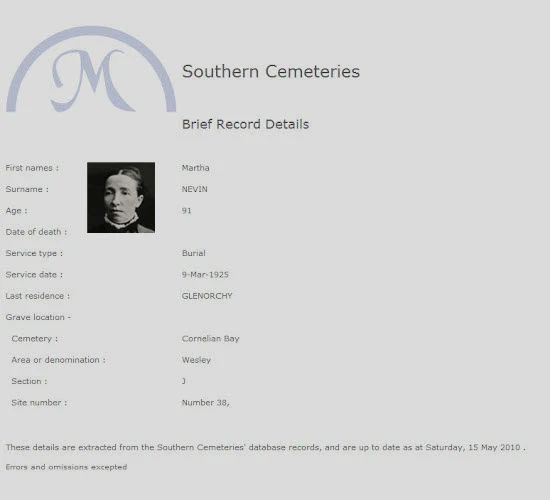 Cemetery record for Martha Nevin, 9 March 1925
S
Cemetery record for Martha Nevin, 9 March 1925
Sandridge, Victoria, 1870s, a busy port where Mary Ann Nevin's husband, mariner John Carr worked, and where he remained after her death, surrendering his new-born daughter to his father-in-law, John Nevin snr, back at Kangaroo Valley, New Town, Tasmania in 1878.
 View Sandridge Pier Melbourne (c. 1870s)
National Gallery of Victoria, Melbourne
Accession Number 2002.406
View Sandridge Pier Melbourne (c. 1870s)
National Gallery of Victoria, Melbourne
Accession Number 2002.406
RELATED POSTS main weblog





















